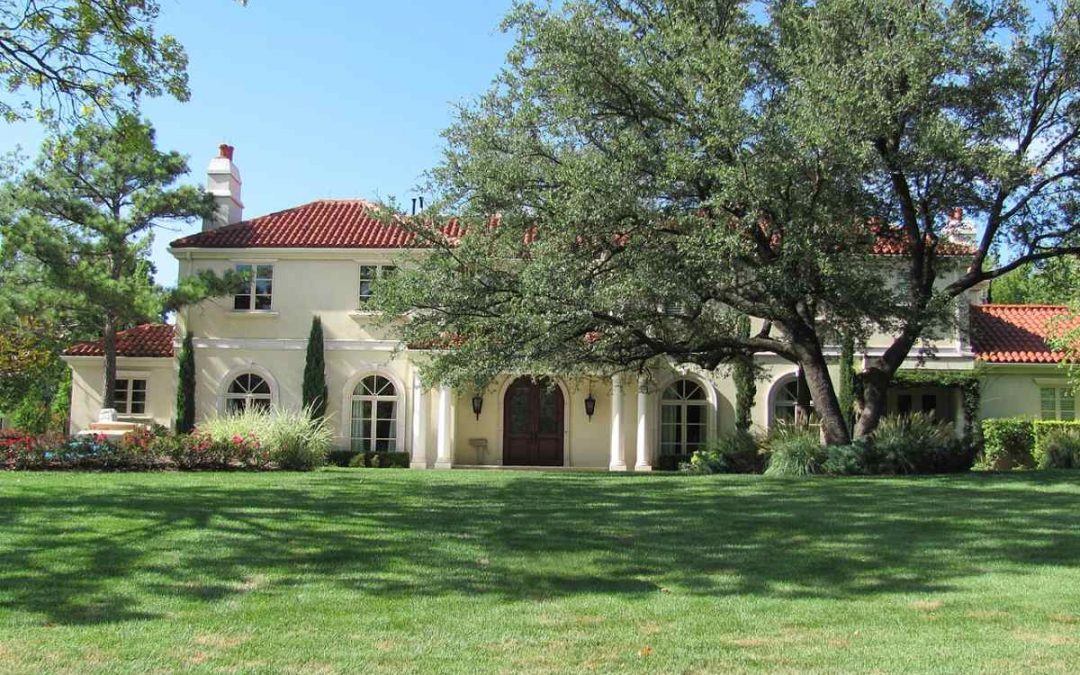Several parts of Oklahoma are prone to tough periods of drought, especially in northwest counties, such as Cimarron, Texas, and Beaver. If you reside in similarly affected areas, it is vital you design a landscape that can tolerate drought conditions. If not, your yard could require plenty of maintenance and constant spending. So we’ve compiled a list of drought-tolerant landscaping ideas for Oklahoma, helping you spruce up your backyard in an efficient, cost-effective manner.
In this article, we will cover:
- What is a Drought-Tolerant Landscape?
- 8 Drought-Tolerant Landscaping Ideas
- Why Choose a Drought-Tolerant Landscape
- FAQ About Drought-Tolerant Landscaping
- Get a Drought-Tolerant Landscape With a Pro
What is a Drought-Tolerant Landscape?
When a landscape is drought-tolerant, it can thrive with little to no supplemental water. It consists of boulders, hardscapes, native perennials, and other features that are considered low-maintenance. Essentially, they are features or plants that can withstand dry periods.
However, drought-tolerant does not mean zero water needs. Native plants that tolerate drought may still require some amount of water to grow or survive. They are not entirely resistant to drought, but their water needs are quite low compared to other high-maintenance plants. This is one of the key purposes of a drought-tolerant landscape— conserving water!
The upcoming section will cover 8 ideas for a drought-tolerant landscape, including hardscapes and artificial turfgrass.
8 Drought-Tolerant Landscaping Ideas
1. Native Plants
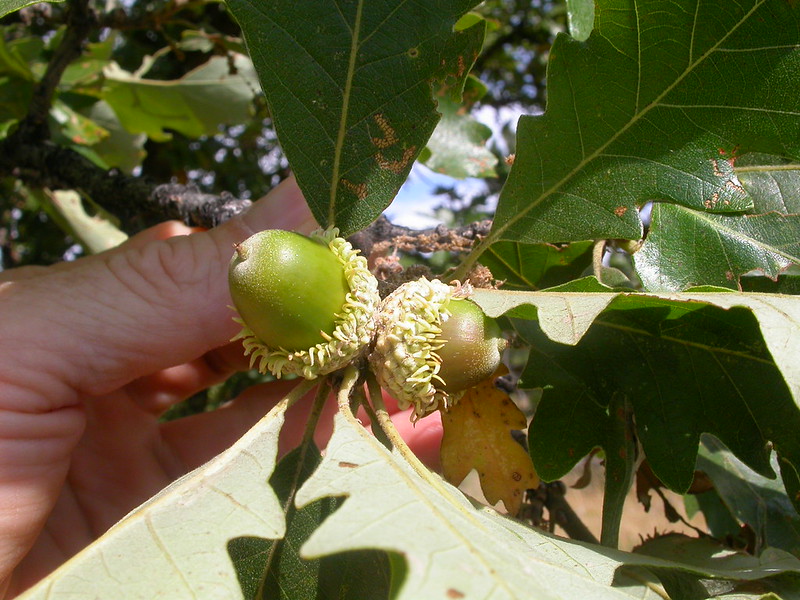
Photo Credit: Matt Lavin / Flickr / CC BY-SA 2.0
Native plants grow naturally in Oklahoma, comfortably able to thrive as they are accustomed to its climate and soil conditions. Going native can reduce the amount of time spent on maintenance, attract hummingbirds and beneficial pollinators, and boost the local ecosystem.
However, not all Oklahoma native plants are able to withstand dry periods. Some trees or wildflowers require plenty of water to grow, so they are obviously not a good fit for your low-maintenance landscape. Additionally, you need to consider your area’s plant hardiness zone to select the right drought-tolerant plants.
To help your decision-making process, below are some suggestions for native drought-tolerant plants:
- Bur oak (Quercus macrocarpa)
- Marigold (Tagetes)
- Red hot poker (Kniphofia triangularis)
- Prickly pear (Opuntia macrorhiza)
- Russian sage (Perovskia atriplicifolia)
- Autumn sage (Salvia greggii)
- Verbena (Verbena canadensis)
Estimated cost: Depending on the plant’s size and type, expect to pay between $600 and $3,000 per flower bed, $25 and $50 per shrub, $150 and $3,000 per tree.
2. Rain Garden
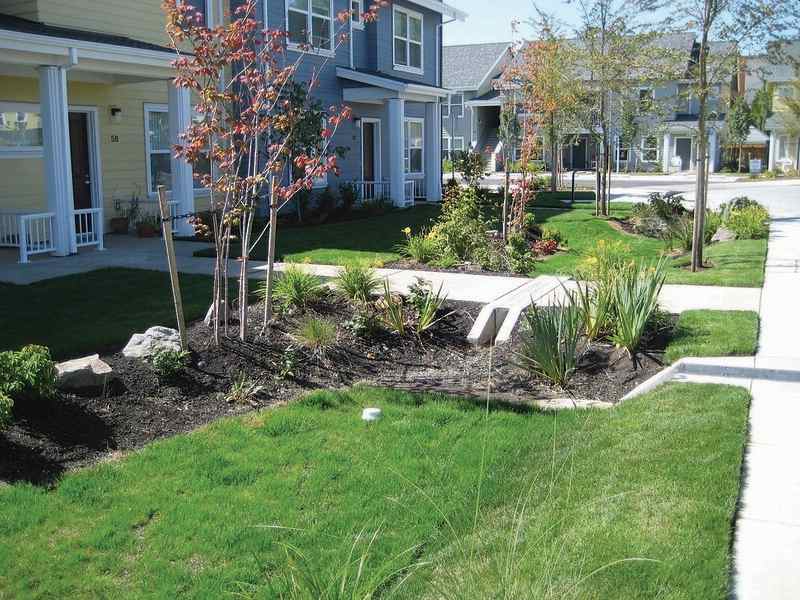
Photo Credit: Oregon State University / Flickr / CC BY-SA 2.0
A rain garden is a planted depression that collects rainwater runoff from the surrounding landscapes. For this type of garden, the soil and plants are uniquely selected to absorb the collected water. You can also add local rocks to the rain garden, to set garden borders or just to increase your yard’s visual appeal. In a way, a rain garden lets mother nature do all the watering for us.
In addition to conserving water, here are some key benefits of a rain garden:
- Can absorb 30% more rainwater than a regular lawn
- More cost-effective than pipes and drains
- Can filter pollutants carried by rainwater; improve its quality before it reaches local rivers and lakes
- Natural habitat for birds, butterflies, and other wildlife
- Reduce chances of flooding on the property
- Add beauty to your landscape, increase property value
Estimated cost: Installing a rain garden yourself will cost $3 to $5 per square foot, depending on the materials and plants you use. If you decide to hire a professional, installation may cost between $10 and $15 per square foot.
3. Artificial Grass
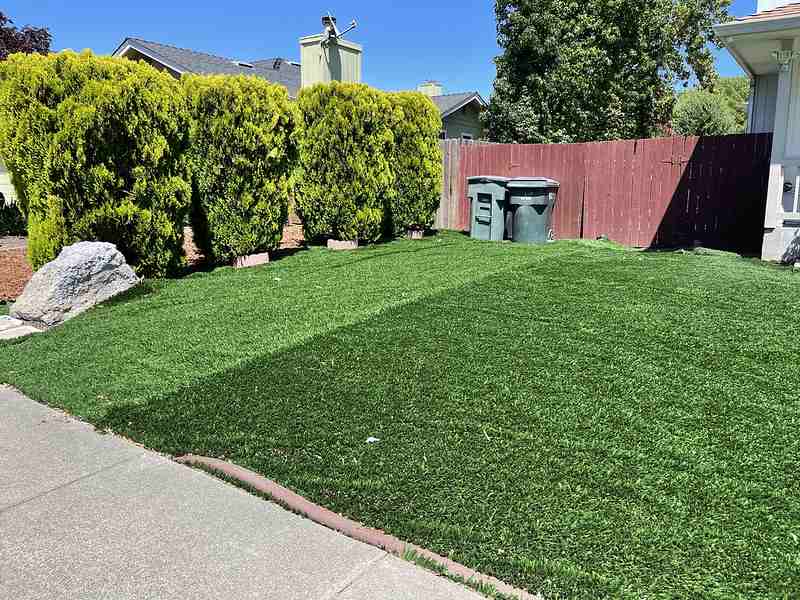
Photo Credit: Sarah Stierch / Flickr / CC BY 2.0
If you wish a green lawn all year round, artificial grass is the way to go. You won’t have to worry about any damage from your kids running around playing lawn games. Just when you think it couldn’t get any better, synthetic turf doesn’t require any water! Artificial grass can withstand harsh weather conditions, including periods of drought.
Despite its high upfront cost, it can be a worthwhile investment and a terrific option for a drought-tolerant landscape.
Here are some benefits of artificial grass:
- Reduces the need for chemical fertilizers and pesticides
- Water-efficient
- No need to hire a lawn care professional
- Long-lasting solution
Estimated cost: Hiring a professional landscaper to install artificial grass will cost you between $5 and $20 per square foot on average.
4. Mulch
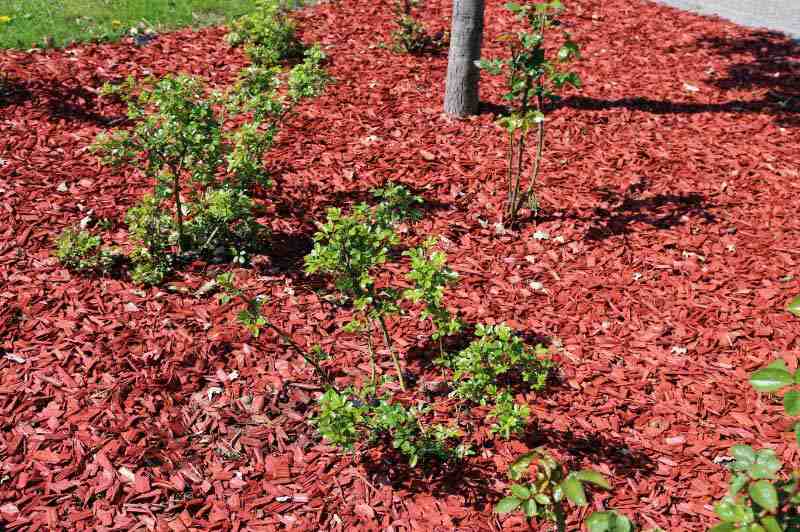
Photo Credit: U. J. Alexander / Canva Pro / License
Simply put, mulch is an easy and cheap way to keep your garden bed hydrated. If you add some on top of deep-rooted plants with low water needs, you’ll get yourself a drought-tolerant yard. Mulch keeps your plant beds moist during the dry summer heat. You can add organic mulch that benefits the soil, or go for the aesthetically pleasing option with inorganic mulch.
Organic mulch:
- Not made of synthetic materials
- Can suppress weeds, but not as efficient as inorganic mulch
- Best for adding beneficial nutrients to the soil
- Includes bark, grass clippings, and shredded leaves
Inorganic mulch:
- Doesn’t add nutrients to the soil
- No natural materials
- Best for fully blocking weeds
- Includes gravel and stone, plastic and landscape fabric
Advantages of mulch:
- Adds nutrients to the soil (if organic)
- Regulates soil temperature
- Protects roots from harsh weather
- Controls the growth of weeds
- Retains moisture in the soil
- Valuable component for a drought-tolerant landscape
Estimated cost: This depends on which type of mulch you choose. Wood mulch costs between $3 to $5 per 2 cubic foot bag, while landscape gravel costs between $4 to $30 per 0.5 cubic foot bag.
5. Drip Irrigation
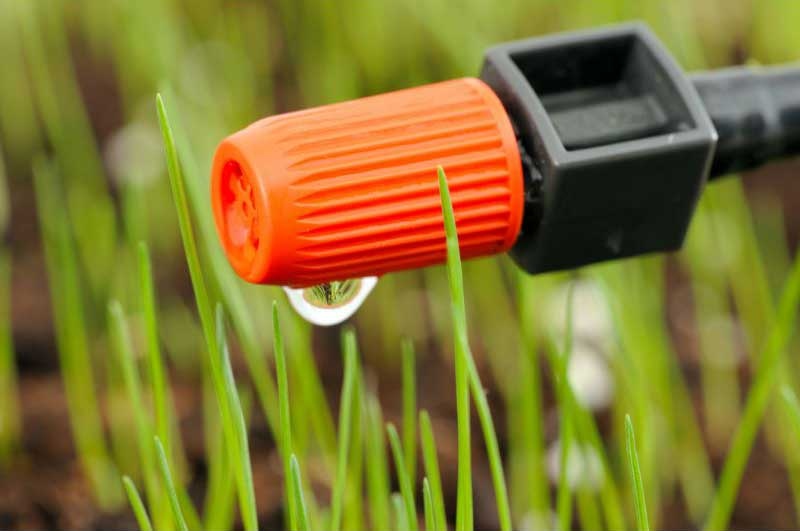
Photo Credit: GrigoriosMoraitis / Canva Pro / License
Drip irrigation will prevent water being wasted by runoff or evaporated. This installation applies water at the plant root zone where it’s needed the most. Because of this, soil moisture levels are kept at an optimal level. You can apply drip irrigation in your vegetable or perennial garden, even to water shrubs or trees. Overall, it is an efficient and economical way to water your garden.
Here are some other benefits of drip irrigation:
- Saves money, time, and water
- Keeps rows between plants dry, reducing weed growth
- Reduces leaching of water below the plant root zone
Estimated cost: Most homeowners pay between $295 and $775 for a drip irrigation system.
6. Rock Garden
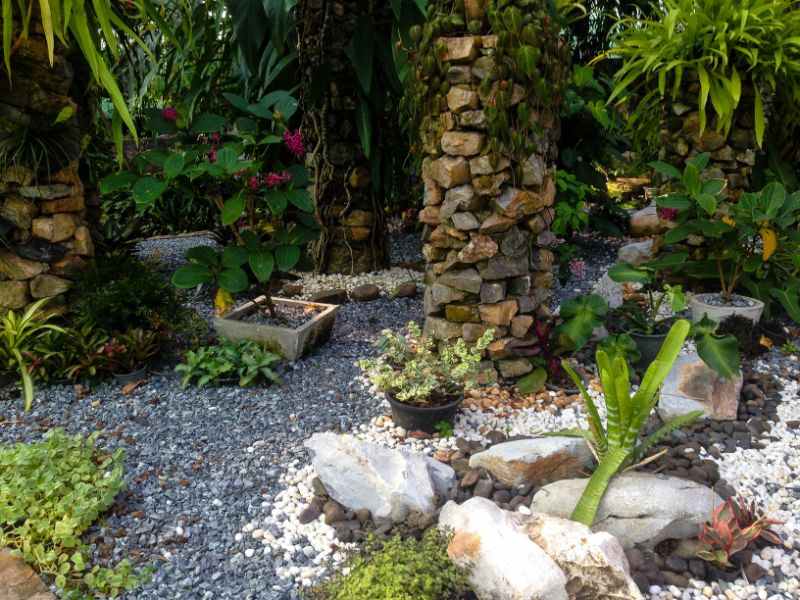
Photo Credit: LookTarn / Canva Pro / License
If you’re looking for an alternative to turfgrasses, look no further than a rock garden. With low water and maintenance needs, a rock garden takes trimming, weeding, and mowing off your to-do list. It features carefully arranged rocks, boulders, or stones. Consider adding succulents or perennial flowers to create a beautiful, colorful, and inviting garden.
If designing a rock garden seems like a back-breaking task, stick to smaller boulders or stones that can easily be moved around. This would allow you to reshape your garden whenever you feel like mixing things up a little.
Estimated cost: Rock garden projects will cost you between $600 and $700 on average. To buy and install rocks or boulders yourself, the cost will range from $460 to $1,000, depending on the size and type of rock.
7. Hardscapes
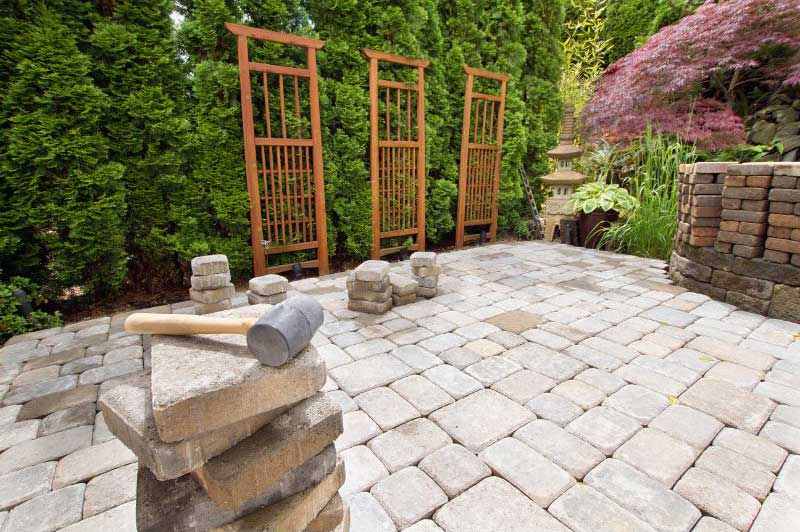
Photo Credit: JPLDesigns / Canva Pro / License
Hardscapes are naturally low-maintenance features that are perfect for a drought-tolerant landscape. They are non-living elements that can improve your outdoor space functions. Unsurprisingly, they require no watering, pruning, or fertilizing. It’s great being able to relax with your family and friends around a fire pit, not worrying about countless hours of outdoor chores.
These decorative and practical structures may still require some care, such as basic cleaning. Unless something goes majorly wrong, hardscaping does not require continuous maintenance for long periods of time.
Here are some examples of hardscaping for a drought-tolerant yard:
- Walkways
- Fountains
- Patios
- Decks
- Fire pits
- Fencing
- Outdoor kitchen
Estimated cost: The cost will depend on the project size and type of feature you choose. Expect to pay between $2,000 and $4,500 for fencing, $370 and $2,235 for a fire pit, $5,055 and $17,275 for an outdoor kitchen.
8. Xeriscaping
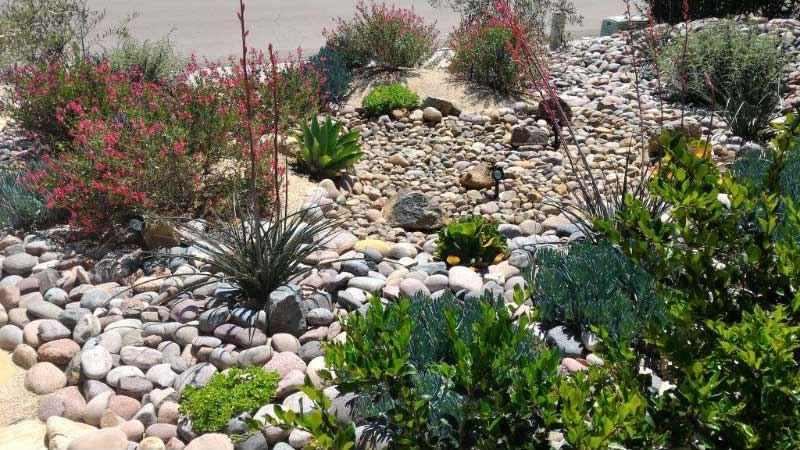
Photo Credit: remedypic / Canva Pro / License
We’re not following the “save the best for the last” format, but xeriscaping is certainly among the best ideas for a drought-tolerant landscape. Its essential purpose is to use as little water as possible, helping you obtain a low-water and low-maintenance garden. Xeriscaping can help you reduce water bills, cut back on energy consumption, and eliminate chores such as mowing and weeding.
Additionally, it can attract beneficial insects and promote biodiversity. For a drought-tolerant landscape, xeriscaping is highly recommended. It can help you create a beautiful and eco-friendly landscape with minimal water consumption.
Xeriscaping can include:
- Drought-tolerant groundcovers
- Succulents
- Retaining walls
- Rainwater recycling system
Estimated cost: This depends on the size and type of project. For example, the cost of a groundcover ranges from $10 to $25. On average, homeowners spend between $5 and $20 per square foot on xeriscaping.
Why Choose a Drought-Tolerant Landscape
A drought-tolerant landscape does have financial benefits, but it also supports the local wildlife habitat. Native plants may serve as a valuable food source for many birds and insects, while a rain garden cleans the rainwater before it reaches lakes or rivers.
Here are more reasons why every Oklahoma homeowner should opt for a drought-tolerant landscape:
- Suitable for Oklahoma’s climate
- Reduce energy consumption
- Lower your water bill
- Minimal maintenance work
- Get rid of unwanted weeds or grass with hardscaping features
- Chance to replace existing, high-maintenance features with low-water ones
FAQ About Drought-Tolerant Landscaping
In short, yes. A lot of homeowners think they’re the same concept, but their main difference can be spotted in each of the terms. Using plants as an example, drought-tolerant means they can withstand drought for a limited period only. If they go through months and months without any water, the plants could wither and die.
On the other hand, drought-resistant plants are ones that can go without water for long periods of time. Cacti are great examples of such plants, as we automatically picture them in dry, sunny areas.
Oklahoma lies in the South Central region of the United States, so it should come as no surprise that many parts of the state suffer from drought conditions. Areas northwest of Oklahoma City suffer more than the likes of Lincoln, Pittsburg, or McCurtain Counties.
To monitor the drought map and get weekly updates, you can check Oklahoma’s drought status here.
A low-maintenance, drought-tolerant landscape will still require the occasional upkeep. Nothing major, but just enough to keep all your features in tip-top shape.
Here are simple ways to care for your drought-tolerant yard:
• Yearly mulching
• Water your new plants until they are established
• Aerate your soil yearly
• Trim, prune, and weed when needed
• Test your soil every 3 to 5 years (pH, condition..)
Get a Drought-Tolerant Oklahoma Landscape With a Pro
A drought-tolerant landscape has several advantages. It helps you save time, reduce maintenance costs, and keep your area’s climate healthy. Transforming your landscape will result in a more sustainable, cost-effective, and valuable property.
There are many plant species that thrive in the local climate. Explore the best native plants for Oklahoma to freshen up your garden with long-lasting trees and beautiful wildflowers. If your turfgrass is beginning to look grim and patchy, check out the best grass types for Oklahoma and enjoy barbecues on a lush, green lawn.
Looking to spend the weekend with your family at the Oklahoma City Zoo? Hire a local lawn care pro to trim the shrubs, mow the lawn, or plant drought-tolerant turfgrass such as Bermudagrass. We have trusted lawn care pros in Oklahoma City, Bixby, Okmulgee, and many other cities across the state.

